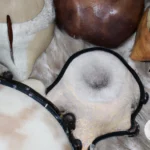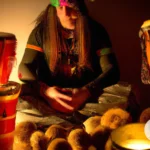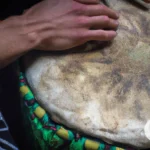Are you interested in shamanic practices and looking to purchase a shamanic drum? Choosing the right shamanic drum can be a daunting task, with so many factors to consider such as size, materials, sound, and design. The ultimate guide to choosing a shamanic drum is here to help you make an informed decision. This article will provide you with all the necessary information about the history and importance of shamanic drums, factors to consider when buying a drum, types of drums, where to purchase one and how to use it for healing and journeying purposes. By the end of this guide, you’ll have a deep understanding of what to look for and how to best use your shamanic drum. So, let’s dive into the world of shamanic drums!
What is a Shamanic Drum?
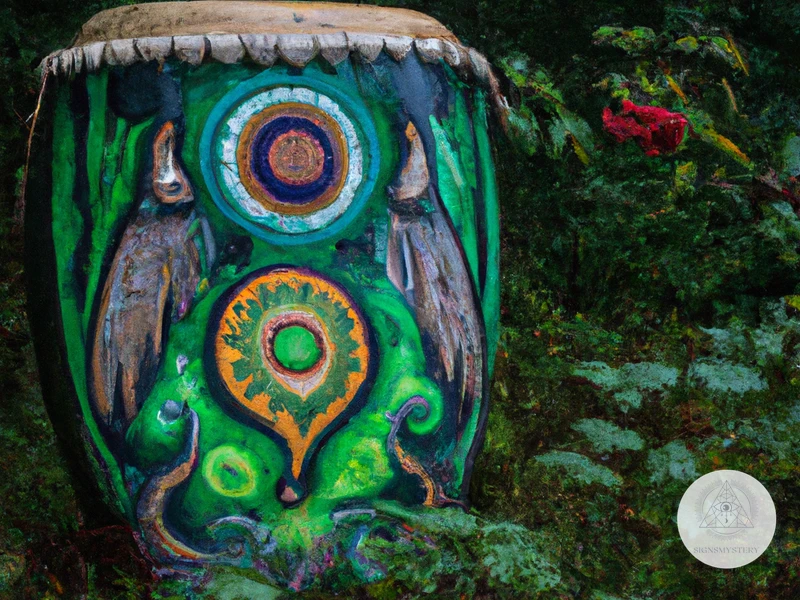
A Shamanic Drum is a powerful tool used in shamanic practices across various cultures. It is believed to connect shamans with the spirit world and aid in their journeying, healing, and divination. The drum has a deep, resonant sound that mimics the heartbeat of Mother Earth, and it is often accompanied by chanting or singing. Shamans use different drumming techniques and rhythms to alter their states of consciousness and access the spirit world. The importance of the drum in shamanism cannot be overstated, as it is a key instrument in most shamanic rituals and ceremonies. To learn more about the role of the shamanic drum in healing and journeying, check out this article.
History of Shamanic Drums
Shamanic drums have been used for thousands of years by indigenous cultures all over the world for spiritual and healing purposes. The exact origin of shamanic drums is unknown, but they have been found in archaeological sites dating back to prehistoric times.
In Siberia, shamanic drums were used in shamanistic rituals and were made from wood and animal hide. These drums were often embellished with symbols and colors, each carrying their own meaning. The Sami people of northern Scandinavia also used shamanic drums in their rituals and believed that the sound of the drum represented the heartbeat of the Earth.
Native American shamans used drums made from animal hides stretched over wooden frames, with each drum having its own unique design and sound. The drum was seen as a sacred object, representing the natural world and the spirits. According to tradition, the Great Spirit gave drums to the Native American people as a means of communication with the spirit world.
In Africa, drums were used for communication, celebration, and healing. Different types of drums were used for different purposes, with each tribe having their own unique designs and rhythms. The drums were played with both hands and sticks, and their sound was believed to have the power to bring people together and heal the sick.
Throughout history, shamanic drums have played a significant role in spiritual and healing practices. The sound of the drum is believed to induce a trance-like state, allowing for communication with the spirit world and bringing about healing for both individuals and communities. To this day, shamanic drums continue to be an important tool in shamanism and spiritual practices.
If you want to learn more about shamanic drumming and techniques, check out our article on basic drumming techniques in shamanism.
Importance of Shamanic Drums in Shamanism
Shamanic drums are powerful tools used in shamanism for various purposes. The importance of shamanic drums in shamanism cannot be overstressed. The drum is viewed as a living being, and the sounds it produces are believed to connect the shaman to the spirit world. The repetitive beats of the drum help the shaman reach an altered state of consciousness, enabling them to communicate with the spiritual realm.
Shamanic drums are essential in shamanic ceremonies and rituals. The sound of the drum is used to call upon the spirits and energies of the universe. The drumbeat creates a bridge between the physical and the spiritual worlds, and the shaman is able to travel to other dimensions. The drumbeat is believed to be the heartbeat of the mother earth, a unifying pulse that connects all things.
Shamanic drumming also plays an important role in healing. The drumbeat, which produces a range of frequencies, can help restore balance and harmony to the body, mind, and spirit. The vibrations produced by the drum can entrain brainwaves, leading the listener to a state of deep relaxation. In this state, the body is better able to heal itself.
Shamanic drums are essential for shamanic journeying. During a shamanic journey, the shaman uses the drumbeat to enter into a trance state. The journeyer travels to other realms to receive messages from the spirits. The drumbeat is also used to lead the journeyer out of the trance state and back to reality.
Shamanic drums hold great significance in shamanism. They are used in ceremonies, healing, journeying, and other rituals. The repetitive drumbeat is believed to connect the shaman to the spirit world, leading them to altered states of consciousness. The power of the shamanic drum should not be underestimated as they carry the heartbeat of the earth, the universe, and all things. To learn more about basic drumming techniques in shamanism, check out this article.
Factors to Consider When Buying a Shamanic Drum
When choosing a shamanic drum, there are several factors to consider. First, the materials used to make the drum can impact the sound and durability. Animal hides and rawhide are commonly used for the drum head, while the frame can be made from wood or metal. The size and weight of the drum should also be taken into account, as they can affect the ease of portability and playing comfort. Sound is perhaps the most important factor, as the drum’s tone should be pleasing to the player and create the right vibrations for shamanic uses. Lastly, design can be a personal preference or may hold special significance, such as incorporating sacred symbols or colours. Finding a shamanic drum that matches your unique needs and desires is crucial for successful shamanic drumming.
Materials
When choosing a shamanic drum, the material it’s made from is an important factor to consider. Most shamanic drums are made from animal hide, typically deer, elk, buffalo, or horse. Each of these hides has a different feel and sound. For example, buffalo hides tend to be thicker and have a deeper, richer sound compared to deer hides which are thinner and have a higher pitch. Elk hides are a popular choice for their balance of thickness and resonance. It’s important to note that some people may have ethical concerns about using animal hides, in which case synthetic options are available.
The frame of the drum can be made from a variety of materials as well, with the most common being wood. Different woods, such as maple or birch, can each affect the tonal qualities of the drum. Some drums may have a metal frame, which can create a more resonant sound but can also be heavier to hold for extended periods of time. When considering the materials of your shamanic drum, it’s important to think about what feels comfortable to you while also considering the sound quality you desire.
An additional factor to consider is the drumstick, which can be made from different materials such as wood, bone, or synthetic materials. Each of these materials creates a unique sound and can also affect the life span of the drum head. For example, synthetic materials can lead to more wear and tear on the drumhead over time. Ultimately, the material of your shamanic drum should be chosen based on your personal preferences, ethical considerations, and desired sound quality.
NOTE: If you want to learn more about the role of shamanic drumming in spiritual practices, check out our article on the importance of drumming in shamanic journeying.
Size and Weight
When choosing a shamanic drum, size and weight are important factors to consider. The size of the drum affects the pitch and resonance of the sound it produces. The larger the drum, the deeper the sound it produces, while smaller drums have higher-pitched sounds. The weight of the drum affects how it feels in your hands and how easy it is to carry.
Some shamanic practitioners prefer larger drums for their deeper resonance, while others prefer smaller drums for their convenience of transportation and higher pitch. Shamanic drums typically range from 14-24 inches in diameter, with depths of 2-4 inches. It is important to choose a drum that feels comfortable and balanced in your hands, as you will be using it for prolonged periods of time during shamanic ceremonies and drumming circles.
In addition to personal preference, the size and weight of the drum should also be considered in relation to the intended use. If the drum will be used for personal journeying or meditation, a smaller size and lighter weight may be more suitable. However, if the drum will be used in larger ceremonies or outdoor settings, a larger size and heavier weight may be necessary to produce enough volume to be heard by all participants.
It is also important to consider the size and weight of the drum in relation to the drum beater. The beater should be proportionate to the drum size, with larger drums requiring larger beaters. A properly sized beater will help produce the best possible sound and extend the life of the drum.
Size and weight are just two of the important factors to consider when choosing a shamanic drum. Take some time to find the right drum that suits your individual needs and preferences, and enjoy the magic of shamanic drumming.
Sound
When considering purchasing a shamanic drum, the sound it produces is an important factor to consider as it has the power to transport you into different states of consciousness. A shamanic drum should produce a deep, resonant sound that can reach into the depths of your soul. The sound should be consistent and clear, without any muffled or dampened tones.
The tone of the drum can be affected by the size, thickness, and type of material used for the drumhead. Generally, thicker drumheads produce a lower pitch while thinner drumheads produce a higher pitch. In addition to the thickness, the type of hide used, such as elk, moose, or horse, can also affect the sound.
The sound of the shamanic drum is crucial when it comes to shamanic practices. It is believed that spirits are attracted to the sound of the drum and can use it as a portal to communicate with the shaman. To achieve the desired sound, it is recommended to test the drum before purchasing to ensure it produces the right vibrations that resonate with you.
While the pitch and tone of the drum are important, it is equally important to ensure that the sound is not too loud to the point of being jarring or disruptive. This can interfere with the flow of energy and disrupt the balance of the space. It is recommended to select a drum that produces a sound that is audible but not overpowering.
When purchasing a shamanic drum, one of the key factors to consider is the sound it produces. The sound of the drum has the potential to create powerful experiences that can transport us into different states of consciousness. Take the time to test the drum and find one that resonates with you on a deep level, as it will be your tool for connecting with the spiritual realm.
Design
is also an important consideration when choosing your shamanic drum. The design of your drum serves several purposes. It can reflect your personality, beliefs, and cultural heritage. A well-designed drum can also enhance your drumming experience by creating a visual and tactile connection to the drum. When choosing a design, consider the following factors:
Color: The color of your drum can evoke different emotions and energies. For example, black represents grounding and protection, while white represents purity and spirituality. Choose a color that resonates with you and the intention of your drumming.
Patterns: The patterns on your drum can also have symbolic meanings. For example, circles represent wholeness and unity, while spirals represent growth and transformation. Choose a pattern that reflects your intention or personal symbolism.
Materials: The materials used to make your drum can also influence its design. For example, a drum made with goat hide may have a different texture and color than one made with elk hide. Consider the natural qualities of the materials and how they can enhance your design.
Symbols: Incorporating symbols into your design can add depth and meaning to your drum. For example, you may choose to add a symbol of a particular animal or spirit that you feel connected to. This can imbue your drum with their energy and make it a powerful tool for Shamanic practice.
Remember to choose a design that resonates with you and your intention for your shamanic drum. A well-designed drum can enhance your drumming experience and make it a powerful tool for Shamanic practice.
Types of Shamanic Drums
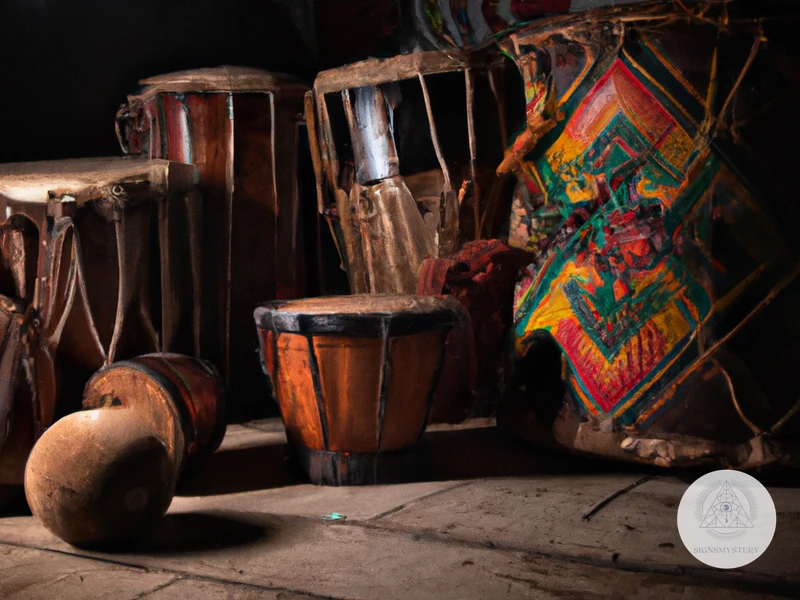
Shamanic drums come in various types, each representing a particular culture or region. Mongolian or Siberian drums, also known as shaman drums or hoop drums, are usually smaller and have a higher pitch. They are characterized by their unique lacing pattern, which represents the journey of the shaman to the spirit world. Native American drums are larger and often have a deep, resonant sound. They usually feature animal hide and intricate artwork that holds cultural significance. African drums are also notable for their intricate designs and are often used in traditional ceremonies and rituals. Other types of drums include Celtic drums and Oceanic drums. Each type of shamanic drum has its unique qualities and playing styles. Understanding the history and culture behind each drum can enhance your shamanic practice and connection to the spirit world. To learn more about the role of drumming in shamanism, check out our article on shamanic drumming.
Mongolian or Siberian Drums
Mongolian or Siberian drums are said to be some of the most powerful shamanic drums. These drums are typically large in size, measuring up to 24 inches in diameter, and are made from animal hides such as horse, elk, or reindeer. The drums are commonly decorated with symbols of shamanic power and are used to create a deep and resonant sound for shamanic journeys.
The materials used for Mongolian or Siberian drums are carefully selected based on their spiritual significance. Horsehide is said to represent spiritual power, elk hide symbolizes strength and protection, while reindeer hide is believed to have healing powers. The hides are sourced from animals that have been raised in a traditional and humane way, with respect and gratitude for the animal’s sacrifice.
One unique feature of Mongolian or Siberian drums is the presence of a handle, which allows the drummer to carry the drum easily during journeys. The handle is also said to represent the drum’s connection to the spiritual world.
When played, Mongolian or Siberian drums produce a deep, earthy sound that is said to connect the drummer to the energy of the land and of nature. This sound is created by striking the drumhead with a special drumstick called a “beater.” The beater is typically made from wood and is decorated with symbols of shamanic power.
Some specific types of Mongolian or Siberian drums include the shaman’s “frame drum,” which is lightweight and easy to carry, and the larger “horse drum,” which is believed to have been used in ancient shamanic ceremonies. The horse drum is typically decorated with symbols of spiritual power and is played during rituals that involve calling in the spirits of the land.
Mongolian or Siberian drums are powerful shamanic tools that are made from carefully selected materials and are decorated with symbols of spiritual power. When played, these drums create a deep and resonant sound that is believed to connect the drummer to the energy of the land and of nature. The presence of a handle on these drums also allows for easy transport during shamanic journeys.
Native American Drums
are one of the most well-known and iconic types of shamanic drums. They are often made from a single piece of wood, with a stretched hide over the top. Traditionally, Native American drums were made from animal hides, and the size and shape of the drum varied depending on the tribe that created it.
The drumming style of Native American drums is often slower than other styles, with a deep, resonant sound that is thought to evoke a sense of grounding and connection to the earth. Many Native American tribes believe that drumming can connect the physical and spiritual worlds, and that the sound of the drum can carry prayers and messages to the spirit realm.
There are several types of Native American drums. The most common is the Powwow drum, which is made from a large, round frame and can be played by a group of people at once. Other types of Native American drums include the water drum, which is traditionally used in rainmaking ceremonies, and the hand drum, which is smaller and often used in personal healing ceremonies.
One well-known Native American drumming tradition is the Ghost Dance, which was a religious ceremony that swept through many tribes in the late 1800s. The Ghost Dance involved drumming, singing, and dancing in an effort to connect with spirits and bring about a new era of peace and harmony.
If you’re interested in playing a Native American drum, it’s important to consider the type of drum that will best suit your needs and intentions. You may want to seek out a drum that has been made by a Native American craftsman, or you may choose to make your own drum using traditional methods. Either way, a Native American drum can be a powerful tool for connecting with the spiritual realm and grounding yourself in the present moment.
To learn more about Native American drumming and its healing properties, check out our article on shamanic drumming songs and spirit messages. Or, if you’re looking for inspiration for your drumming practice, consider creating a custom shaman drum rhythm that speaks to your unique spiritual journey.
African Drums
African drums, also known as djembe drums, have a unique shape and sound that make them stand out from other types of drums. They are traditionally crafted by hand from a single piece of wood, often from the Mali or Guinea region of West Africa. Djembe drums are an important part of African culture and are commonly used in rituals, ceremonies, and storytelling.
Materials: African drums are typically made from hardwoods such as lenge, iroko, or dimba, which are native to West Africa. The drumhead is often made from goat skin or cowhide, which can affect the sound of the drum.
Size and Weight: African drums commonly range in size from around 20 to 25 inches tall, with a drumhead diameter of around 10 to 13 inches. They are relatively lightweight and easy to carry, making them a popular choice for drum circles and performances.
Sound: The sound of African drums is distinctive, with a deep bass tone and sharp slap and tone sounds. This is achieved through the use of different playing techniques and the varying thickness and tension of the drumhead.
Design: African drums often feature intricate designs and carvings, which can be symbolic and meaningful. The base of the drum is traditionally carved with images of animals or symbols of nature.
Some popular types of African drums include:
- Djembe: The most common African drum, with a goblet shape and a skin stretched over the top. It is played with bare hands and can produce a wide range of tones.
- Ashiko: A conical-shaped drum that produces a deep, resonant sound.
- Doundoun: A large bass drum played with sticks, often used in traditional African dance performances.
- Bougarabou: A hourglass-shaped drum that produces a high-pitched, melodic sound.
If you’re interested in learning more about African drumming and rhythm, check out our article on custom shaman drum rhythm and explore the rich history and culture of African music.
Other Types of Drums
In addition to the well-known types of shamanic drums, there are also a number of other drums that can be used for shamanic purposes.
One such drum is the Ocean Drum, which is a unique type of shamanic drum that has a drumhead on both sides. The drumhead is filled with small steel balls, which simulate the sound of the ocean when moved. This drum is used to create a calming, healing atmosphere during shamanic ceremonies.
Another type of shamanic drum is the Gonga drum, which is a large, bass-heavy drum that is commonly used in African Shamanic traditions. This drum typically produces low, booming sounds which are said to help ground the shaman and the participants in the ceremony.
The Frame drum is also a popular type of shamanic drum that has been used for centuries in various cultures around the world. This drum is lightweight and has a simple design, consisting of a wooden frame and a single drumhead. It is often used in shamanic healing practices to create a rhythmic beat that helps to induce an altered state of consciousness.
The Tongue drum is another type of shamanic drum that is becoming increasingly popular in modern shamanic practices. This drum has a unique design, with several “tongues” that can be struck to produce different tones. It is said to produce a soothing, meditative sound that helps to shift the consciousness of the shaman and the participants.
Ultimately, the choice of drum will depend on personal preference and the traditions practiced by the shaman. Each type of drum has its own unique sound and feel, and the shaman will need to experiment with different types to find the one that resonates with them the most.
Where to Buy a Shamanic Drum
When considering where to buy a shamanic drum, there are several options to choose from. One option is to look for online stores that sell shamanic drums, which can offer a wide variety of options to choose from. Another option is to visit shamanic supply stores, where you can often find knowledgeable staff who can help guide you in choosing the right drum for your needs. For those looking for a truly unique drum, handmade drums can be purchased directly from the artist or through artisan markets. Regardless of where you decide to purchase your shamanic drum, it’s important to do your research to ensure that the drum is made from quality materials and that it will meet your specific needs.
Online Stores
When it comes to buying a shamanic drum, online stores are a great option. There are several online stores that specialize in shamanic supplies, and they offer a wide variety of drums to choose from.
One benefit of shopping for a shamanic drum online is the convenience. Instead of having to physically go to a store, you can browse and make purchases from the comfort of your own home. Additionally, online stores often have a larger selection of drums to choose from than physical stores.
However, it’s important to keep in mind that you won’t be able to see and touch the drum before purchasing it. This means you won’t be able to gauge the weight or sound of the drum in person. To offset this, many online stores will provide detailed descriptions of their drums, including size and weight measurements, as well as
Subscribe to Our Newsletter
Sign up to receive the latest news and updates.
Another consideration when shopping at online stores is the reputation of the seller. Make sure to read reviews from previous customers and only purchase from reputable sellers to ensure you receive a quality drum.
When shopping online, you may also want to consider the shipping costs and delivery time. Some online stores may offer free shipping, while others may charge a fee. Additionally, delivery times can vary based on your location and the store’s shipping policies.
Shopping at online stores can be a convenient and efficient way to purchase a shamanic drum. Just be sure to do your research and shop from reputable sellers to ensure you receive a quality drum that meets your needs.
Shamanic Supply Stores
are specialized stores that cater to the needs of shamanic practitioners. These stores offer a vast selection of shamanic drums, shakers, rattles, and other instruments at reasonable prices. They also provide other tools and materials that are essential in shamanic practice, such as smudge sage, crystals, and herbs. Some examples of shamanic supply stores are:
| Store Name | Location | Products Offered |
|---|---|---|
| Sacred Hoop Trading Company | Sedona, Arizona | Shamanic drums, rattles, flutes, and smudge sage |
| The Sacred Well | Oakland, California | Shamanic drums, smudge kits, tarot decks, and crystals |
| Shamans Market | Boulder, Colorado | Shamanic drums, rattles, shakers, and herbs |
These stores are run by experienced shamanic practitioners or individuals who have a strong connection to shamanism. They can provide valuable insights and advice to customers, such as which drum is best suited for their needs. Additionally, they may offer workshops and training for those who are new to shamanism.
If you are unable to find a shamanic supply store near you, do not worry. Many of these stores now have an online presence, which allows customers to browse and purchase items from the comfort of their own homes. Online stores like Shaman’s Market and Sacred Hoop Trading Company offer a vast selection of shamanic drums and other tools that are shipped directly to your doorstep.
Remember that when purchasing a shamanic drum from a supply store, it is essential to keep in mind the factors mentioned earlier, such as materials, size and weight, sound, and design. Ensure that the drum you select resonates with you on a personal level and is suited to your specific needs as a shamanic practitioner.
Shamanic supply stores are valuable resources for individuals who practice shamanism. They offer a wide range of shamanic tools and products, provide helpful insights and advice, and often run workshops and training. If you are unable to find a store near you, many of these stores also have an online presence. Just remember to consider the essential factors when purchasing a shamanic drum from these stores.
Handmade Drums
Handmade drums are a popular choice among many shamanic practitioners. These drums are carefully crafted by skilled artisans using traditional techniques. Each drum has its unique character and beauty, and they are made with natural materials such as skins, wood, and plant dyes.
One of the benefits of choosing a handmade drum is that it is made with attention to detail and care. Artisans who make these drums are often knowledgeable about the spiritual significance of the drum and the materials used to make it. They may use materials that are sacred or have special meaning in a particular tradition.
When purchasing a handmade drum, it is important to consider the reputation and skill of the artisan or maker. Some artisans may specialize in making a particular type of drum, such as a Native American hoop drum, or a Mongolian shamanic drum. It is also important to ensure that the materials used to make the drum are ethically sourced and sustainable.
Buying a handmade drum can be a significant investment, but it is also an opportunity to own a unique piece of art that can bring joy and inspiration to your shamanic practice. Handmade drums often come with care instructions and may require special handling to maintain their quality and sound.
Handmade drums are a popular choice for shamanic practitioners who value the authenticity and beauty of traditional craftsmanship. When purchasing a handmade drum, it is important to do your research and choose a reputable artisan who uses natural and sustainable materials. With proper care and attention, a handmade drum can be a valuable tool for your shamanic practice for years to come.
How to Use Your Shamanic Drum
Using a shamanic drum involves preparation, grounding and centering, and specific drumming techniques. To prepare your drum, you may want to cleanse it with sage or another purifying herb. It’s important to ground yourself before beginning your drumming practice, which can be done through meditation or deep breathing exercises. Centering involves finding balance and focus, which can be achieved through mindfulness practices. When it comes to drumming techniques, there are various rhythms and beats that can be used for different purposes. For example, a slower beat may be used for healing while a faster beat may be used for journeying. Maintaining your drum is also important for its longevity, which can involve periodically conditioning the hide and storing it in a cool, dry place.
Preparing Your Drum
Preparing your shamanic drum is an important ritual that should not be taken lightly. Before using your drum for any spiritual practice or ceremony, it’s essential to set the right intention and show respect for the drum’s power. Here are some steps you can take to prepare your drum for use.
Cleansing Your Drum
The first step in preparing your shamanic drum is to cleanse it. This can be done using various methods, such as smudging with sage, palo santo or sweet grass, or even burying it in the earth for a few days. The goal is to remove any negative energies that may have accumulated on the drum from manufacturing or previous use. Cleansing the drum helps to purify it and open it up to the spiritual realm.
Tuning Your Drum
Once your drum is cleansed, it’s time to tune it. This means finding the right sound that resonates with you and your intention. To tune your drum, hold it in your lap or on a stable surface and strike it gently with a mallet or your hand. Listen carefully to the sound produced and experiment with different strikes until you find the pitch that feels right for you. You can also use a tuner to help you achieve the desired note.
Blessing Your Drum
After you have cleansed and tuned your drum, it’s time to bless it. This is a personal ceremony that should reflect your spiritual beliefs and intentions for the drum. You can say a prayer, chant, or simply offer gratitude for the drum’s power and connection to the spiritual realm. Some people like to use essential oils or holy water to anoint the drum, while others prefer to hold it in the sunlight or under the moon to charge it with energy.
Storing Your Drum
Once you have prepared your drum, it’s essential to store it properly to maintain its energy and longevity. Keep it away from direct sunlight and moisture, as this can damage the skin and affect the sound. Store it in a cool, dry place, preferably in a drum case or bag to protect it from dust and scratches. Avoid storing the drum near electronics or other sources of electromagnetic energy, as this can interfere with its vibration.
Preparing your shamanic drum is a sacred act that connects you to the natural world and the spiritual realm. By following these steps and setting the right intention, you can create a powerful tool for healing, meditation, and spiritual growth. Remember to treat your drum with respect and care, and it will serve you well for many years to come.
Grounding and Centering
Grounding and Centering:
Grounding and centering are crucial elements of shamanic drumming. Before you begin your drumming practice, it is essential to ground yourself and achieve a state of centeredness. Here are some techniques you can use to ground and center yourself before a shamanic drumming session:
| Meditation: | Meditation is a powerful tool for grounding and centering. Sit comfortably in a quiet place and focus on your breath. Imagine your breath as a grounding force, pulling you down towards the earth. Allow your mind to become still and peaceful. |
| Physical touch: | Physical touch can be a useful tool for grounding. Place your feet firmly on the ground and press them down. Imagine roots growing from your feet into the earth, anchoring you to the ground. |
| Affirmations: | Affirmations can help you achieve a state of centeredness. Repeat a positive affirmation to yourself, such as “I am grounded and centered” or “I am connected to the earth.” Visualize yourself as rooted and grounded. |
| Breathwork: | Deep breathing can be a powerful grounding technique. Take several deep breaths, inhaling through your nose and exhaling through your mouth. Allow your breath to become slow and even. |
Achieving a state of groundedness and centeredness before shamanic drumming can help you connect more deeply with the spiritual world. It also allows you to be present and focused during your drumming session, maximizing the benefits of your practice.
Remember to take a few moments to ground and center yourself before each shamanic drumming session. With regular practice, you will find it easier to achieve this state of being, and your drumming practice will become even more fulfilling.
Drumming Techniques
One of the most important aspects of playing a shamanic drum is developing drumming techniques. When done correctly, drumming can induce a trance-like state, helping the shaman to journey and connect with the spirit world.
Rhythm is an essential ingredient in effective drumming. The shaman must establish a steady beat that can be maintained for the duration of the journey. This beat should be simple and repetitive, allowing the shaman to get into a meditative state.
Dynamics play a significant role in drumming as well. The shaman must learn how to use the drum to create different levels of intensity and energy throughout the journey. For example, when journeying through a challenging spiritual terrain, the shaman may increase the volume and speed of the drumming to create a sense of urgency.
Breath is also important in drumming techniques. As the shaman plays the drum, they should breathe deeply and intentionally, allowing the breath to guide their rhythm. This helps the shaman to connect with their body, mind, and spirit.
Sticking techniques also contribute to the overall sound of the drum. The shaman should experiment with different ways of hitting the drum, such as using the fingers, palms, or sticks, to create different tones and sounds.
Syncopation is another drumming technique that can add complexity and interest to the rhythm. By playing around the beat, the shaman can create a more varied and dynamic soundscape, which can help to deepen the journey experience.
It’s important to note that mastering shamanic drumming techniques takes time and patience. It’s not something that can be learned overnight. The shaman should practice regularly, experimenting with different techniques and rhythms until they find what works best for them.
Ultimately, the goal of shamanic drumming is to create a powerful and transformative experience for both the shaman and their clients. By mastering drumming techniques, the shaman can tap into the healing power of the drum and use it to facilitate deep spiritual growth and transformation.
Drumming for Healing and Journeying
Drumming for healing and journeying is one of the primary uses of shamanic drums. The repetitive beat of the drum can alter brain-wave patterns and induce an altered state of consciousness. This state is conducive to accessing the spiritual realm to receive healing and guidance.
When drumming for healing, the shamanic practitioner will set an intention for the healing to take place. They may also call upon allies in the spiritual realm, such as power animals or ancestors, for assistance. The drumming will then begin at a slow, steady pace and gradually increase in intensity as the practitioner focuses on the healing intention. The volume and intensity of the drumming will vary depending on the nature of the healing being sought.
Drumming for journeying involves entering into a trance-like state in order to access the spiritual realm for guidance and insight. The shamanic practitioner will set an intention and then begin drumming at a steady pace to enter into the trance state. Once in the trance state, the practitioner may journey to specific locations in the spiritual realm or encounter spirit guides and power animals.
It is important to note that drumming for healing and journeying should be done with the guidance of an experienced practitioner. It is also important to create a safe and conducive space for the practice. This may include smudging with sage or other cleansing herbs and setting up a sacred space with crystals and other spiritual tools.
Drumming for healing and journeying is a powerful practice that can help individuals access the spiritual realm for healing, guidance, and insight. However, it should be done with caution and under the guidance of an experienced practitioner. Creating a safe and sacred space is also crucial for the practice.
Maintaining Your Drum
Maintaining your Shamanic Drum is essential if you want it to last for years to come. Here are some tips to keep your drum in top condition.
Storage: When you’re not using your drum, store it in a cool, dry place that is not exposed to direct sunlight or extreme temperatures. Consider wrapping it in a cloth or placing it in a protective bag to prevent dust from accumulating on the surface.
Cleaning: Use a soft, dry cloth to wipe down the surface of your drum after each use to remove any dirt or debris that may have accumulated on it. Avoid using water or any cleaning solutions on the surface of your drum as this could damage the hide.
Humidity: Drumheads are made from animal hides and can be affected by fluctuations in humidity. Too much humidity can cause the hide to stretch and become loose, while too little humidity can cause the hide to shrink and crack. To maintain the optimal humidity level for your drum, consider using a humidifier or dehumidifier depending on the climate of your area.
Tuning: The sound of your drum may change over time due to changes in humidity or the natural stretching of the hide. If this occurs, you can adjust the sound by tightening or loosening the lacing on the drumhead. A drum that is too loose will produce a flat sound, while a drum that is too tight can produce a higher pitch.
Avoiding Damage: Avoid exposing your drum to extreme temperatures or direct sunlight for extended periods of time as it can cause the hide to dry out and crack. Additionally, be careful not to drop or bump your drum as this can cause damage to the rim or the head.
By taking care of your Shamanic drum, you’ll be able to continue to enjoy its benefits for many years to come.
Conclusion
In conclusion, choosing the right shamanic drum for your needs is essential for a successful shamanic practice. Remember to consider the materials, size and weight, sound, and design of the drum before making a purchase. Additionally, understanding the different types of shamanic drums available can help you find one that resonates with your spiritual practice.
When purchasing a shamanic drum, it is important to consider the quality and craftsmanship of the drum. Handmade drums may cost more but can offer a unique and personal touch. Whether you choose to purchase your drum from an online store, shamanic supply store, or handmade by a local artisan, make sure to do your research and choose a reputable seller.
Once you have selected your shamanic drum, it is important to prepare it properly and maintain it regularly. This includes grounding and centering yourself before use, experimenting with different drumming techniques, and storing it properly to prevent damage.
Overall, the shamanic drum is a powerful tool for tapping into the spirit world and accessing deeper levels of consciousness. By following this ultimate guide, you can choose the perfect drum to enhance your shamanic practice and open up new spiritual possibilities.
| Key takeaways: |
|---|
| Consider: |
| – The materials, size and weight, sound, and design of the drum |
| – Handmade drums for a personal touch and quality craftsmanship |
| – Grounding and centering before use, experimenting with different techniques, and proper storage |
| Remember: |
| – The shamanic drum is a powerful tool for spiritual growth and deeper consciousness |
| – Do your research and choose a reputable seller when purchasing a shamanic drum |
Frequently Asked Questions
What is the purpose of a shamanic drum?
A shamanic drum is used by shamans in various cultures to enter into altered states of consciousness for spiritual purposes such as healing, divination, and journeying.
What are shamanic drums made of?
Shamanic drums are traditionally made of animal hide, typically deer, elk, buffalo, or horse, stretched over a wooden hoop. The drumsticks can be made of wood or bone.
What size and weight should a shamanic drum be?
The ideal size and weight of a shamanic drum will depend on personal preference and intended use. Generally, a diameter of 14″ to 18″ and a weight of 3-6 pounds are standard.
What types of shamanic drums are there?
Mongolian or Siberian drums, Native American drums, and African drums are the most well-known types of shamanic drums. However, there are also lesser-known types from various other cultures around the world.
What is the difference between a shamanic drum and a regular drum?
Shamanic drums are specifically designed for shamanic journeying and spiritual purposes. They have a deeper resonance and are played in a specific way to aid in trance-like states.
Where can I buy a shamanic drum?
Shamanic drums can be purchased online, at shamanic supply stores, or from individual craftspersons who specialize in handmade drums.
How do I prepare my shamanic drum for use?
Before using your shamanic drum, it’s important to set a personal intention for its use and to take some time to “wake up” the drum by playing it for a few minutes each day for a week or so.
What are drumming techniques for shamanic journeying?
The most common technique for shamanic journeying involves a steady, repetitive beat at around 180 beats per minute. Shamans may also use various rhythms and tones to achieve different effects.
How long can I journey with my shamanic drum?
Shamans typically recommend journeys of 15-30 minutes to prevent physical exhaustion or overuse of the drum. However, the length of journeys can vary depending on individual capacity and intention.
How do I maintain my shamanic drum?
To care for your shamanic drum, don’t expose it to excessive heat or humidity, and store it in a cool, dry place when not in use. You can also treat the hide with oil or beeswax to keep it supple and prevent cracking.



